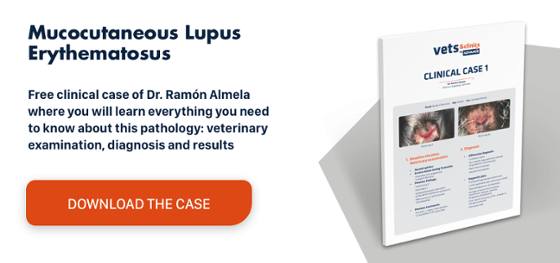Folliculitis in dogs: diversity of Staphylococcus pseudintermedius in lesions
Bacterial folliculitis is a relatively common skin disorder in veterinary practice, especially in short-haired dogs. It is a superficial pyoderma that affects the upper portion of the hair follicle and is often confused with dermatophytosis.
What causes bacterial folliculitis?
Bacterial folliculitis is characterised by the presence of small, bullseye-shaped pustules or papules with hair emerging from the centre. These may be accompanied by epidermal collarettes and scabs, hyperpigmentation, alopecia and inflammation.
The aetiologic agent of folliculitis in dogs is usually Staphylococcus pseudintermedius, a bacterium normally found in the mucocutaneous junctions of the nose, mouth and perianal region, as well as on the skin of the chin and interdigital spaces.1
In some cases, when skin immunity is impaired due to a primary disease, this resident bacterium becomes an opportunistic pathogen that causes the infection. As such, bacterial folliculitis is usually secondary to other skin conditions, such as infectious, parasitic, allergic or autoimmune dermatitis. It may also be due to defective keratinisation of the epidermis and follicles or an endocrine disorder.
New approaches to the treatment of folliculitis in dogs
Superficial bacterial folliculitis usually has a good prognosis with the correct treatment, but it can also become a chronic and/or recurrent condition if the underlying cause is not identified or cannot be controlled satisfactorily because the medication or duration of treatment are inadequate.
Folliculitis in dogs has been treated with empirical systemic antibiotics and minimal topical therapy, but in recent times this approach has been questioned and recommendations are for a topical therapy for mild and localised lesions, as proposed by Borio S, Colombo S, La Rosa G, et al. in a study published in Veterinary Dermatology.2
Antibiotic therapy should be restricted to cases of generalised folliculitis, deep pyoderma and recurrent folliculitis. Considering the resistance some strains have developed, an analysis by Dr. Jangi Bajwa3 recommendedselecting therapy based on the cytology, along with culture and sensitivity results, and combining this with topical therapy where possible using a narrow-spectrum antibiotic.
The problem is that Staphylococcus pseudintermedius is genotypically diverse among the dog population, so each dog can be colonised by multiple strains. This means that when different strains with distinct antimicrobial resistance profiles are present in superficial bacterial folliculitis, taking samples from a single skin lesion for the culture and antimicrobial susceptibility test could jeopardise treatment success due to the prescription of the incorrect antibiotics.
A study by Larsen et al.4 analysed the diversity of Staphylococcus pseudintermedius in the lesions of 14 dogs with superficial bacterial folliculitis. For each dog they discovered between one and four strains with unique pulsed-field gel electrophoresis profiles and up to three unique antimicrobial resistance profiles. In two dogs, they isolated up to four strains with different antimicrobial resistance profiles from the same lesion.
Multiple pustules from the same dog always contained the same strain, but the papules, scabs and collerettes did not. The researchers therefore concluded that lesions in superficial bacterial folliculitis can accommodate multiple strains of Staphylococcus pseudintermedius with different antimicrobial resistance profiles and pustules are the best lesion for collecting a bacterial culture sample.
It was not clear whether the detection of different strains in other types of lesion was due to contamination or co-infection by multiple strains. However, an article by César L. Yotti Alvarez5 confirmed that Staphylococcus schleiferi can be found in pyoderma, and sometimes also transient Gram-negative colonies of flora (Proteus spp.,Pseudomonas spp. and Coliformes).


